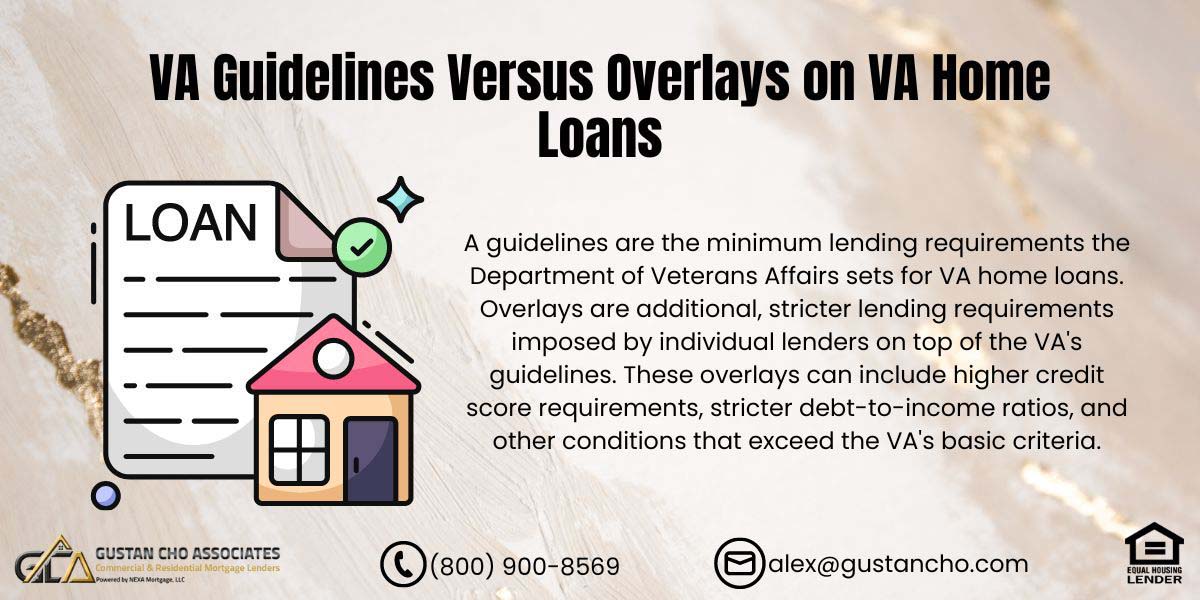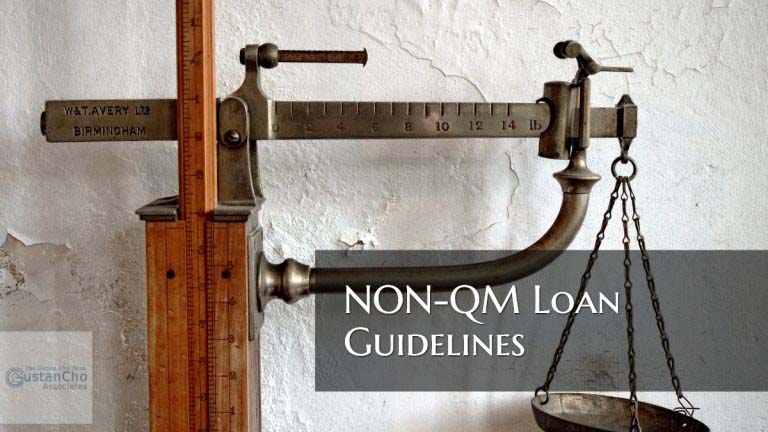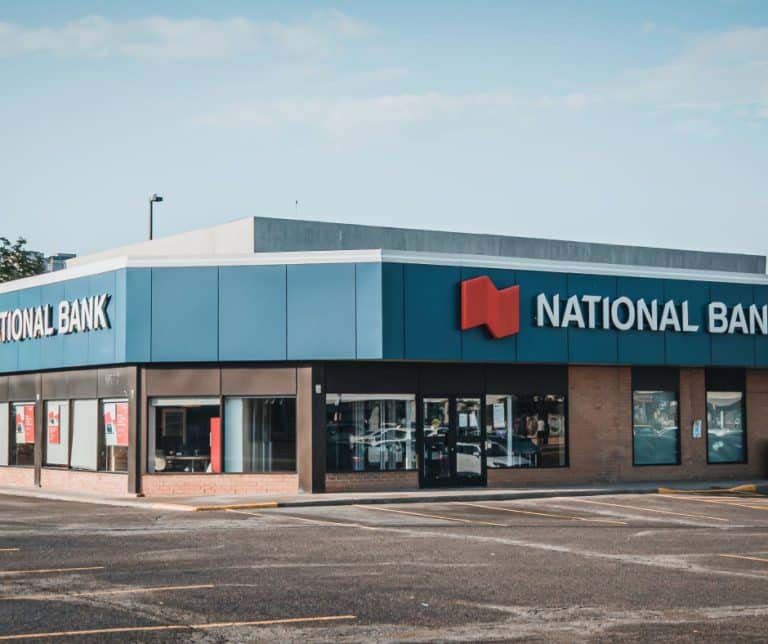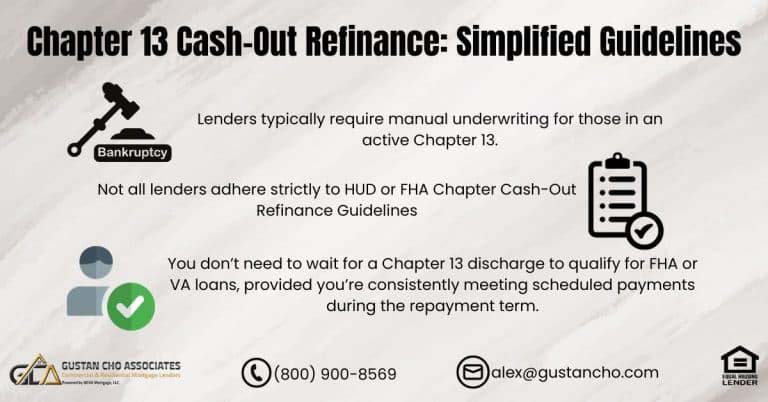This blog will discuss and cover VA Guidelines Versus Overlays on VA loans. Not all mortgage lenders have the same requirements for VA loans. All mortgage lenders require their borrowers to meet the minimum VA agency guidelines set by the Veterans Administration. However, lenders can impose stricter lending requirements beyond the VA guidelines. These additional requirements by mortgage lenders on VA loans are known as overlays.
What Is Overlay on VA Loan?
Most lenders have overlays on VA loans. It is important for mortgage borrowers to understand the difference between VA Guidelines Versus Overlays. The minimum lending guidelines for VA home loans are set by the Department of Veterans Affairs (VA).
John Strange of Gustan Cho Associates explains that lender overlays are additional mortgage requirements imposed by individual lenders, which are stricter than the VA’s minimum guidelines.
As long as borrowers meet the VA’s agency guidelines, they are eligible for a VA loan. Many lenders, however, have their own additional requirements, which can increase borrowers’ difficulty in meeting eligibility. At Gustan Cho Associates, over 80% of our clients could not qualify with other lenders due to overlays, last-minute mortgage loan denials, stress during the mortgage process, or the lender’s need to offer the specific loan product they needed.
Confused About VA Guidelines vs. Overlays? Let Us Help You Understand the Difference!
Contact us today to understand how VA guidelines differ from lender overlays and how we can help you get approved.What Does No Overlays on VA Loans Means
Mortgage lenders can impose additional guidelines, known as lender overlays, that go beyond the minimum agency mortgage guidelines set by the Veterans Administration for VA home loans. While the VA does not mandate a minimum credit score, most lenders require one.
In general mortgage terms, “overlay” or “lender overlays” refers to the extra lending requirements each mortgage lender or wholesale investor may impose. These overlays exceed the minimum guidelines established by government and conventional loans.
Gustan Cho Associates operates without lender overlays on VA loans, allowing them to approve clients with credit scores as low as 500 FICO. In contrast, other lenders typically require a score of 620 or higher. Another common example of lender overlays on VA loans is the debt-to-income ratio (DTI) overlay. The VA does not set a maximum DTI requirement, but most lenders impose overlays, limiting the DTI to between 45% and 50%.
Do Lenders Have The Same Mortgage Overlays on VA Loans?
Lenders can have overlays on various aspects of a loan. Typical lender overlays may include additional requirements on credit scores, debt-to-income ratios, collections, charged-off accounts, manual underwriting, and minimum credit tradelines. At Gustan Cho Associates, there are no lender overlays on government and conventional loans.
Government and conventional loans include FHA, VA, USDA, and conventional loans. Each lender can impose its own lending requirements that exceed the agency guidelines set by the Veterans Administration. These additional requirements are known as lender overlays.
It is entirely legal for a lender to have higher lending requirements than the minimum agency guidelines of the VA. This is why lending requirements for VA loans can vary between lenders. Suppose a borrower does not qualify with one lender due to overlays. In that case, they may still qualify with a different lender that adheres strictly to VA guidelines without additional overlays. Understanding the distinction between VA Guidelines Versus Overlays is crucial for borrowers navigating the VA home loans process.
Do Lenders Have Different Requirements for VA Loans?
Not all lenders have the same type of overlays. Some lenders may have overlays on debt-to-income ratio, while others may overlay on credit scores. Yet a different lender may not do manual underwriting on VA loans. Homebuyers with bad credit are highly recommended to understand the basic VA guidelines versus overlays on VA loans if a lender tells them they do not qualify.
Did they not qualify for a VA loan due to overlays by the lender or because they could not meet the VA agency mortgage guidelines? Many loan officers who disqualify a borrower on a VA loan only specify they do not qualify. They normally do not get into detail. The borrower meets VA agency guidelines and could qualify with a different lender with no overlays.
Yes, Gustan Cho Associates has no lender overlays on VA home loans. Over 75% of clients at Gustan Cho Associates are borrowers who could not qualify at other mortgage companies due to overlays. If you meet the minimum agency guidelines of the VA, you can qualify for a VA loan with a lender with no lender overlays. You can get denied for a VA loan by one lender and get approved with a different lender without lender overlays. Gustan Cho Associates has no lender overlays on VA loans.
What Is Overlay in Credit Risk?
Overlays are what each lender will impose on top of the minimum credit guidelines of the U.S. Veterans Administration due to credit risks. VA loans are a government-backed residential mortgage loan program only available to active and retired Armed Services members with valid COE. Surviving spouses of qualified veterans are also eligible for VA loans.
Borrowers can qualify for a VA loan with prior bad credit. VA does not have a minimum credit score requirement. There is no maximum debt-to-income ratio cap on VA loans. Gustan Cho Associates has qualified, approved, and closed borrowers with 500 credit scores and over 65% debt-to-income ratio on VA loans.
The best VA loan lenders are mortgage brokers with a network of wholesale VA home loan lenders with no mortgage overlays. Mortgage brokers normally have lower rates. VA loans are originated, processed, underwritten, funded, and serviced by private lenders. Lenders love originating VA Loans due to the government guarantee. For borrowers who default and foreclose on their VA Loans, the U.S. Department of Veterans Affairs will partially guarantee the loss sustained by lenders.
Can I Get VA Loan With Collections?
Outstanding collections and charged-off accounts do not have to be paid off. However, timely payments on all the borrower’s monthly payments in the past 12 months are normally required to get an approve/eligible per the automated underwriting system.
You do not need perfect credit to qualify for a VA loan. This is why lenders can offer 100% financing and very low mortgage rates on VA loans. The team at Gustan Cho Associates helps borrowers get approved for VA loans with credit scores down to 500 FICO.
Over 80% of our clients at Gustan Cho Associates are borrowers who have been denied at other lenders due to lender overlays, last-minute loan denials, or because they did not have the mortgage loan products available for the borrower needed. Not all mortgage lenders have the same lending requirements on VA loans.
Getting Denied For a VA Loan After Being Pre-Approved
There are many instances where home buyers get pre-approved for a VA loan by a loan officer and enter into a home purchase contract. The loan process starts, and the mortgage underwriter denies the loan during underwriting. So what happened here? In more cases than not, the loan officer issued a pre-approval because the borrower got an approve/eligible per automated underwriting system (AUS) and met all the VA agency guidelines.
Many borrowers do not understand the concept of VA Guidelines Versus Overlays. What is the difference? All lenders must meet the minimum VA guidelines the Department of Veterans Affairs set forth. However, each lender can have lending standards above and beyond the VAs. These additional lending requirements and standards are called lender overlays.
The loan officer screwed up because they did not thoroughly review their employer’s VA loan overlays. The borrower meets all the VA agency mortgage guidelines. However, the individual lender has lender overlays on VA loans. This is one of the main reasons for getting a mortgage loan denial after being pre-approved on a VA loan. Homebuyers with bad credit and lower credit scores should take time to understand the minimum agency guidelines if they do not qualify with one lender. They can shop for a lender with no overlays on VA loans.
VA Guidelines vs. Overlays – Let’s Make Sure You Get the Loan You Deserve!
Reach out now to see how we can help you qualify for a VA loan with no extra barriers.The Main Reason For A Last-Minute Mortgage Loan Denial on VA Loans
For example, the VA has no minimum credit score requirements or maximum debt-to-income ratio limit. A borrower can get an approve/eligible per automated underwriting system with a 500 credit score and a 65% debt-to-income ratio. However, most lenders will require a 620 credit score and a debt-to-income ratio of less than 50% DTI. This is one of the main causes of a last-minute mortgage loan denial after being pre-approved.
Over 80% of our borrowers at Gustan Cho Associates Mortgage Group are folks who either have gotten a last-minute mortgage denial or are stressing over their VA Mortgage Process with another lender.
The Department Of Veteran Affairs sets VA loan guidelines. Every lender may have different VA lending guidelines. Gustan Cho Associates is one of the very few national lenders with no overlays on VA loans. We do not have any overlays period on VA loans. As long as borrowers meet minimum VA Guidelines and get approve/eligible per the automated underwriting system, we will approve and fund the VA loan.
What Are Typical Overlays By Lenders on VA Loans
There is a big difference between VA Guidelines Versus Overlays. It is important for borrowers with less-than-perfect credit to understand VA Guidelines Versus Overlays. Most lenders have overlays on VA loans. No two mortgage lenders have the same lending requirements on VA loans. One lender may not do a manual underwrite, while a different lender may. VA does not have a minimum credit score requirement. The Department of Veterans Affairs does not have a maximum debt-to-income ratio requirement.
VA Loan Credit Requirements
Most lenders require a 620 to 640 credit score on VA loans and have a debt-to-income ratio cap of 45% to 50%. Gustan Cho Associates has no lender overlays on VA loans. The team at Gustan Cho Associates has qualified, approved, and closed thousands of VA loans with credit scores down to 500 FICO and debt-to-income ratios over 60% DTI. You can get an approve/eligible per automated underwriting system (AUS) on VA loans with credit scores down to 500 FICO and over 60% DTI with strong residual income and solid on-time payment history for the past 12 months.
VA Guidelines Versus Overlays on Debt-To-Income Ratio
Most lenders will have a debt-to-income ratio cap set between 41% to 50% when the VA does not mandate a DTI cap. The Team at Gustan Cho Associates recently closed a borrower with a 580 credit score and 60% DTI. This is because we got an approve/eligible per automated underwriting system. The borrower has plenty of residual income and a very low DTI. Outstanding collections and charged-off accounts were seasoned for over 24 months. This borrower was viewed favorably by the automated underwriting system, which rendered an automated approval. Other lenders have overlays on not being able to do manual underwriting. Many of our businesses at Gustan Cho Associates are VA and FHA Manual Underwriting borrowers.
VA Manual Underwriting Guidelines
Choosing mortgage lenders that will go off VA guidelines versus overlays on manual underwrite is key if you are trying to get approved for a VA loan during the Chapter 13 Bankruptcy repayment plan. If you have just been recently discharged from Chapter 13 Bankruptcy and do not have two years seasoning from the discharge date, choosing a lender that goes off VA guidelines versus overlays is necessary. Not all mortgage lenders will do manual underwriting on VA loans.
Difference Between Manual Versus Automated Underwriting System Approval
The only difference between a manual versus an automated underwriting system approval mortgage process is the cap on the debt-to-income ratio on manual underwrites. Remember, the VA does not have a maximum debt-to-income ratio cap on automated underwriting system approvals. On manual underwriting, the front-end debt-to-income ratio is capped at 31% and back-end DTI at 43% with no compensating factor. 37% front-end and 47% back-end with one compensating factor. 40% front-end and 50% back-end with two compensating factors.
Wondering How VA Guidelines Differ from Overlays? We Can Help You Navigate the Process!
Contact us today to learn about the impact of overlays on your VA loan and how we can help you get approved.Underwriter Discretion on VA Manual Underwriting
Mortgage underwriters have a lot of underwriter discretion in the manual underwriting of VA loans. A mortgage underwriter can easily deny a VA manual underwriting borrower just because they feel the borrower has too much-layered risk and will affect their ability to repay their VA loan. Ronda Butts, a dually licensed realtor and loan officer, explains the fact how mortgage underwriters have a great deal of underwriter discretion on
Conversely, mortgage underwriters can review the recommended manual underwriting debt-to-income threshold if they feel the borrower has a high residual income with multiple compensating factors and go above the maximum recommended debt-to-income ratio using underwriting discretion.
FHA and VA loans are the only two mortgage loan programs that all manual underwriting. One of the key requirements on manual underwriting is you need timely payments in the past 12 months. VA manual underwriting is more lenient than FHA manual underwriting guidelines. This is because the government takes care of its veterans, and many lenders are pro-Military and show favoritism to our veterans.
VA Guidelines Versus Overlays on Manual Underwriting
VA and FHA loans are the only two programs allowing manual underwriting. Sometimes, the Automated Underwriting System (AUS) findings cannot render an approve/eligible. When the AUS renders a refer/eligible per AUS, the file can be downgraded to manual underwriting. There are no debt-to-income ratio caps if the borrower gets AUS Approval. However, there are DTI Caps on VA manual underwriting. The maximum VA debt-to-income ratio for manually underwritten loans with no compensating factors is 41%. The DTI can go up to 50% with compensating factors.
Compensating Factors on VA Loans
Compensating factors are positive factors borrowers have under the eyes of the mortgage underwriter. Compensating factors are necessary for manual underwriting with high debt-to-income ratios. Dale Elenteny, a senior loan officer at Gustan Cho Associates explains the difference between manual and automated underwriting systems:
The major difference between manual versus automated underwriting systems is the lower debt-to-income ratio cap on manual underwriting. The front-end and back-end debt-to-income ratio cap depend on the number of compensating factors the borrower has.
Compensating factors offset the lender’s layered risk factor. Therefore, with strong compensating factors, the lender can go higher on the front-end and back-end debt-to-income ratio cap.
List of Compensating Factors Acceptable By Lenders on VA Loans
Not all positive factors can be used by mortgage underwriters for compensating factors. Some examples of compensating factors include the following:
- Timely credit history for 24 or more months
- part-time job income, bonus income, overtime income that has been seasoned for at least 12 months but not used as income in the mortgage loan application
- conservative utilization of credit by borrowers
- substantial residual income
- Verification of rent with low payment shock: little to no payment shock (5% or less payment shock or less than $100)
- low debt to income ratios
- job longevity in the same field
- history of pay raises and job promotion
- reserves and liquid assets
- sizable down payment
- equity in homes in the past and the history of savings
- child care tax credits
- benefits from the military
- history of homeownership experience
- other factors that provide strength and ability to repay the borrower
- Established credit tradelines that are seasoned for two years or longer
- Full-time income from the non-borrowing spouse not used to qualify for the VA home loan
Finding lenders that will go with VA guidelines versus overlays is key if you have bad credit or lower credit scores.
VA Loans After Bankruptcy and Foreclosure
Mortgage lenders will not accept manual underwriting VA loans as part of their lender overlays. Many lenders will have higher lending requirements above VA guidelines versus overlays on VA loans. There are mandatory waiting periods after bankruptcy and/or housing events to qualify for VA loans:
- Chapter 7 bankruptcy must be discharged for two years
- Allowed to purchase in Chapter 13 bankruptcy repayment plan with a 12-month satisfactory payment history with Trustee Approval
- Chapter 13 does not need to be discharged
- There is no waiting period after the Chapter 13 Bankruptcy discharge date
- Two years from the date of the trustee’s deed after a foreclosure or deed-in-lieu of foreclosure
- Two years from the short sale date.
Stacking a VA Loan: Understanding VA Guidelines Versus Overlays and VA Home Loans
“Stacking” a VA loan, in the context of using multiple VA loans simultaneously, isn’t typical. However, there are scenarios where a veteran can have more than one VA loan at a time under specific conditions. Here’s a detailed look at how this works, considering VA Guidelines Versus Overlays and the principles of VA Home Loans.
Using Multiple VA Home Loans
- Entitlement Calculation: The VA Home Loans program has a concept called entitlement, the amount the VA will guarantee. Veterans can use a portion of their entitlement to secure one loan and still have remaining entitlement for another loan.
- Remaining Entitlement: If a veteran has used part of their entitlement but has yet to use the full amount, they can use the remaining entitlement to purchase another home. This is more common when the veteran’s original loan amount is relatively low.
- Restoration of Entitlement: Veterans can restore their full entitlement if they sell their home and pay off the original VA loan in full or if another qualified veteran assumes the loan.
Common Scenarios for VA Home Loans
- PCS (Permanent Change of Station): A common scenario for multiple VA Home Loans is when a service member receives a PCS and needs to purchase a new home at the new duty station while still owning a home financed by a VA loan at the previous location.
- Investment Property: Veterans can rent their original home (financed with a VA loan) and use the remaining entitlement to buy another primary residence. However, the VA Home Loans program is primarily intended for primary residences, so this must be managed carefully.
Example of Dual VA Home Loans
- First Home: A veteran buys a home for $200,000 using a portion of their VA entitlement.
- New Duty Station: The veteran receives a PCS and needs to buy another home at the new location for $250,000.
- Remaining Entitlement: Depending on the county loan limits and the amount of entitlement used on the first home, the veteran may still have enough entitlement to purchase the second home using a VA loan.
VA Guidelines Versus Overlays
- County Loan Limits: VA loan entitlement amounts can vary based on county loan limits. High-cost areas may allow for higher loan amounts.
- Occupancy Requirements: The VA loan program requires that the property financed with a VA loan be used as the veteran’s primary residence.
- Overlays: Lenders may have overlays, which are additional guidelines on top of the VA’s requirements. These overlays can affect how entitlements and loan approvals are managed.
Important Considerations
Understanding the distinction between VA Guidelines and overlays is crucial. While the VA sets the basic guidelines for VA Home Loans, individual lenders might impose stricter requirements through overlays. Managing entitlements and understanding these rules are key to taking advantage of VA Home Loans.
Need Help Understanding VA Loan Guidelines vs. Lender Overlays? Let Us Guide You!
Reach out now to discuss how these overlays work and how we can help you qualify under the right guidelines.What is a Fixed VA Loan?
A VA fixed-rate loan is a mortgage option for veterans, active-duty service members, and eligible surviving spouses through the VA Home Loans program. This loan features a fixed interest rate that remains constant throughout the loan, providing borrowers with stable and predictable monthly payments.
Fixed VA loans usually have terms lasting 15 to 30 years and provide substantial advantages, such as no need for a down payment, exemption from private mortgage insurance (PMI), and competitive interest rates. Additionally, the VA sets forth guidelines limiting the closing costs that veterans can be charged, making these loans an attractive option.
Understanding VA Guidelines Versus Overlays is crucial when considering a fixed VA loan. While the VA sets the basic eligibility criteria and requirements, individual lenders might impose additional conditions known as overlays. These overlays can affect credit score requirements, debt-to-income ratios, and other factors. Despite these potential overlays, fixed VA loans remain a highly beneficial option for eligible borrowers, offering the advantage of predictable long-term payments and the security of a stable interest rate, protecting them from market fluctuations.
What Is The First Step In Getting a VA Loan?
Borrowers needing a VA Lender licensed in 48 states with no overlays, please get in touch with us at Gustan Cho Associates at gcho@gustancho.com. Or call or text us at 800-900-8569. Gustan Cho Associates have lending partnerships with over 170 wholesale mortgage lenders, including dozens of wholesale mortgage lenders of VA loans with no lender overlays. By no lender overlays on VA loans, we mean absolutely zero lender overlays. We go off the automated underwriting system (AUS) findings with not a single layer of overlays on VA home loans. The Team at Gustan Cho Associates is available seven days a week, on evenings, weekends, and holidays.
FAQs: VA Guidelines Versus Overlays on VA Home Loans
-
1. What are VA guidelines versus overlays in the context of VA home loans? VA guidelines are the minimum lending requirements the Department of Veterans Affairs sets for VA home loans. Overlays are additional, stricter lending requirements imposed by individual lenders on top of the VA’s guidelines. These overlays can include higher credit score requirements, stricter debt-to-income ratios, and other conditions that exceed the VA’s basic criteria.
-
2. Can lenders have different overlays for VA loans? Yes, lenders can have different overlays for VA loans. Each lender may impose additional requirements, such as minimum credit scores, debt-to-income ratio limits, and other criteria. These overlays vary from lender to lender, so a borrower might qualify for a VA loan with one lender rather than another.
-
3. What is a fixed VA loan? A fixed VA loan is a type of mortgage offered under the VA Home Loans program that has a fixed interest rate throughout the life of the loan. This provides stable and predictable monthly payments, typically with terms of 15 to 30 years. Fixed VA loans also offer benefits like no down payment, no private mortgage insurance (PMI), and competitive interest rates.
-
4. How do overlays affect the approval process for VA loans? Overlays can significantly affect the approval process for VA loans. While a borrower might meet the VA’s minimum guidelines, lender overlays can add additional hurdles, such as higher credit score requirements or lower debt-to-income ratio limits. Understanding these overlays is crucial for borrowers needing to shop for a lender with fewer or no overlays to secure a VA loan.
-
5. What should a borrower do if a VA loan is denied due to overlays? If a borrower is denied a VA loan due to overlays, they should seek lenders who adhere strictly to VA guidelines without additional overlays. Lenders like Gustan Cho Associates, which have no overlays on VA loans, might approve borrowers who meet the minimum VA guidelines even if other lenders have denied them.
-
6. Why might one lender approve a VA loan while another denies it? One lender might approve a VA loan, while another denies it because of differing overlays. Some lenders impose additional requirements beyond the VA’s guidelines, such as higher credit score minimums or stricter debt-to-income ratios. Borrowers should understand these differences and consider lenders with no overlays if they meet the basic VA guidelines but face denials from other lenders.
This blog about VA Guidelines Versus Overlays on VA Home Loans was updated on June 12th, 2024.











